an exhaustive (and exhausting) look at khukuri shapes and sizes...

|
by
Daniel Koster
aka pendentive |
Note: All drawings were created
in AutoCAD based on various photographs of khukuris and from several collections.
This is not meant to be a comprehensive or complete set of any/all khukuris
offered by Himalayan Imports. I chose these particular models based on
what khukuris I would reach for if I was to set out into the woods. I have
included the tiny Kagas Katne as well as the massive Janawar Katne as extreme
reference points. I specifically avoided the Kobra, Tarwar, etc. because
they are considered swords and not primarily tool-knives. I also avoided
models that are "done-up" versions of plain khukuris such as the Garud,
Hanuman, etc. Lastly, I left out extremely fancy khukuris like the Kothimodas
which (I hope) would not really be used out "in the field".
Also, it should be noted that the khukuris in these drawings may differ from yours depending on which maker created them. For this study, all khukuris have been rotated to sit as if both the blade and the handle were resting on a countertop. This is to create a datum - or, in other words, a consistent line of reference.
I. overall drawing of the models included in this analysis (all from Himalayan Imports ):
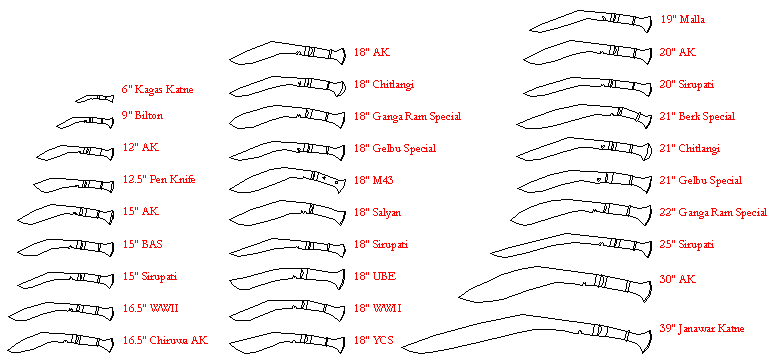
II. The first study is really just an overlay of a grid on top of the khukuris. It is pretty basic, but already you will begin to see differences that are otherwise not so obvious. Perhaps it is a slight slant in the handle. Some khukuris' handles are in a straight line with the blade and some are not. Some curve, some are straight. Have a look:

III. A more advanced analysis can be used to further distinguish the knives by looking at the white space around the outline of the khukuri - that is, the "negative space" (for you artists out there). I draw a distinction between space above and below the handle because the varying shapes and sizes of the blades can sometimes mislead you into thinking one blade has more or less bend in it than another. Look carefully and compare the space beneath the khukuri to get a good handle on the effective striking angle of the knife. A larger area usually means more bend. Also, the area can be weighted to the front or the back which makes a huge difference in the hand.
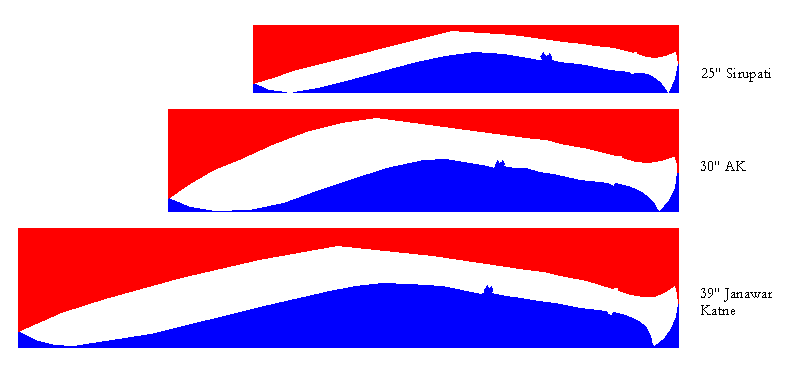
Back to Khukuri FAQ -
main page
Also, it should be noted that the khukuris in these drawings may differ from yours depending on which maker created them. For this study, all khukuris have been rotated to sit as if both the blade and the handle were resting on a countertop. This is to create a datum - or, in other words, a consistent line of reference.
This page looks best at higher screen
resolutions.
Notes for making effective use of these diagrams:
1 - Find 2 (or more) khukuris you are interested amongst the drawings in Part I.
2 - Scroll to Part V. to check the Final Bend Angle and Effective Strike Angle of each khukuri
3 - Then come back to Parts II, III & IV to analyze the finer similarities and differences.
4 - Your best success at utilizing this information will come from making detailed comparisons (vs. rash generalizations).
5 - Lastly, go out and buy one and try it for yourself. Write up an analysis of your own and post it to Bladeforums.com
1 - Find 2 (or more) khukuris you are interested amongst the drawings in Part I.
2 - Scroll to Part V. to check the Final Bend Angle and Effective Strike Angle of each khukuri
3 - Then come back to Parts II, III & IV to analyze the finer similarities and differences.
4 - Your best success at utilizing this information will come from making detailed comparisons (vs. rash generalizations).
5 - Lastly, go out and buy one and try it for yourself. Write up an analysis of your own and post it to Bladeforums.com
I. overall drawing of the models included in this analysis (all from Himalayan Imports ):

II. The first study is really just an overlay of a grid on top of the khukuris. It is pretty basic, but already you will begin to see differences that are otherwise not so obvious. Perhaps it is a slight slant in the handle. Some khukuris' handles are in a straight line with the blade and some are not. Some curve, some are straight. Have a look:
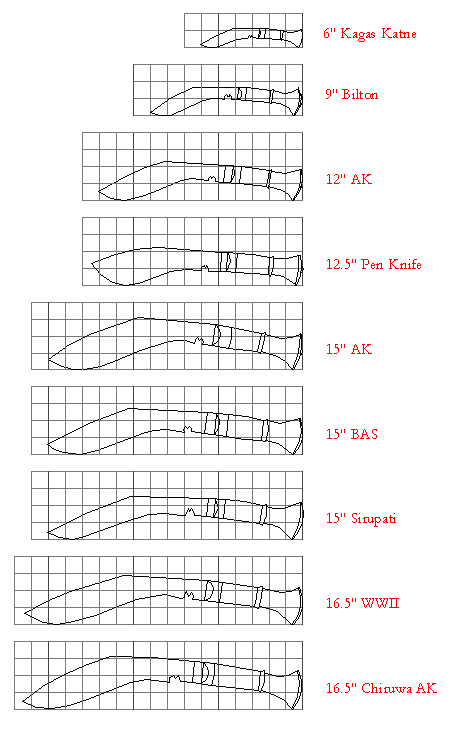
|
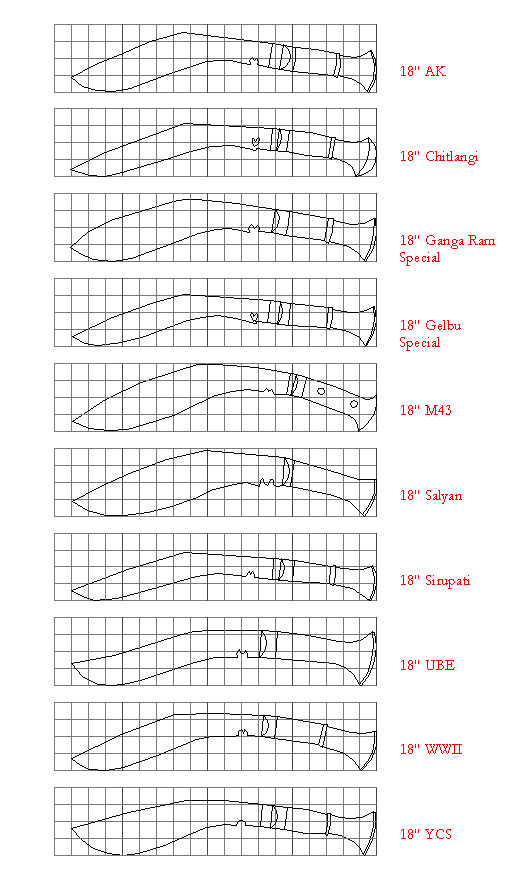
|
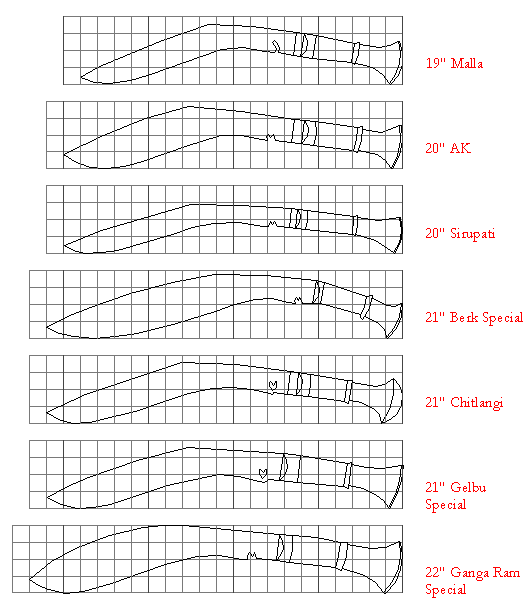
|

III. A more advanced analysis can be used to further distinguish the knives by looking at the white space around the outline of the khukuri - that is, the "negative space" (for you artists out there). I draw a distinction between space above and below the handle because the varying shapes and sizes of the blades can sometimes mislead you into thinking one blade has more or less bend in it than another. Look carefully and compare the space beneath the khukuri to get a good handle on the effective striking angle of the knife. A larger area usually means more bend. Also, the area can be weighted to the front or the back which makes a huge difference in the hand.
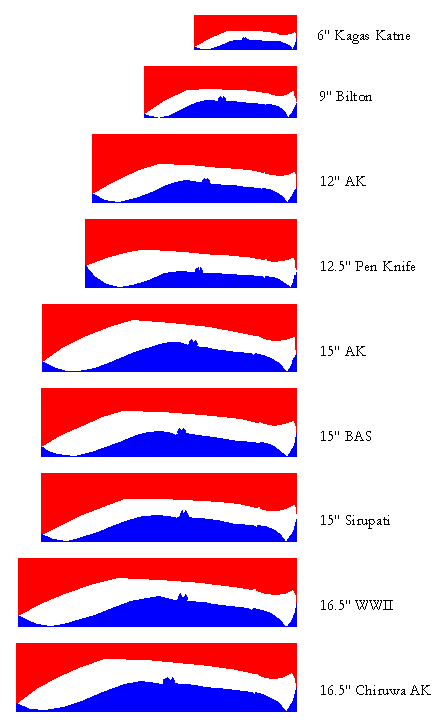
|
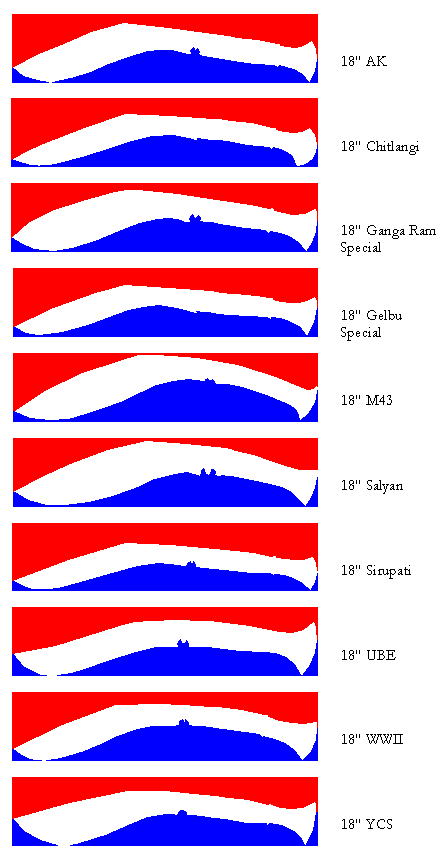
|
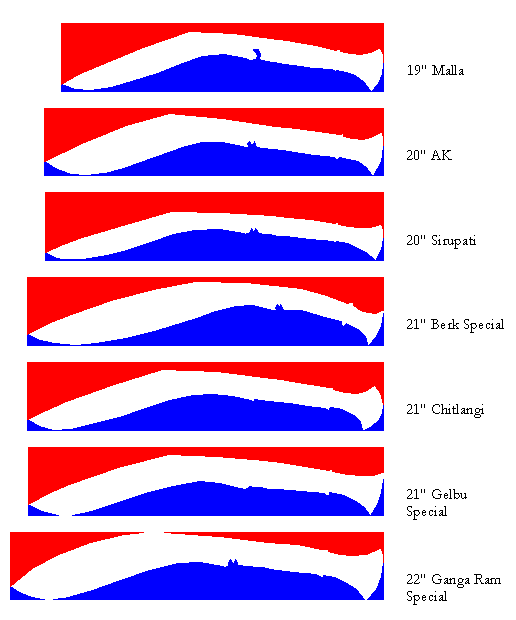
|

IV. This study is more of
a demonstration for the last part of this analysis. I drew lines on the khukuris
centering on the handles and blades. I tried to keep it simple, using a
maximum of 4 lines. Even where the knife is curved, it can be expressed by
2 lines (2 for the handle, 2 for the blade). This will make sense later.
But, once you read the last part of the analysis (section V), you will surely
want to flip back and forth to these drawings and that's why I included them.
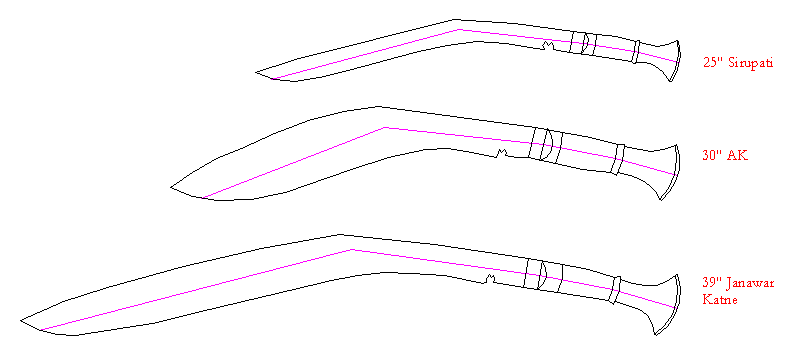
a. small khukuris - 6-12.5 inches

b. 15-16.5 inch khukuris

c. 18 inch khukuris
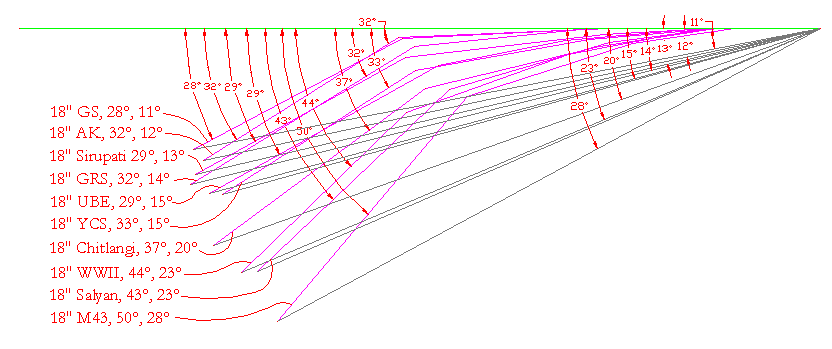
d. 19-21 inch khukuris

e. 25-30 inch khukuris

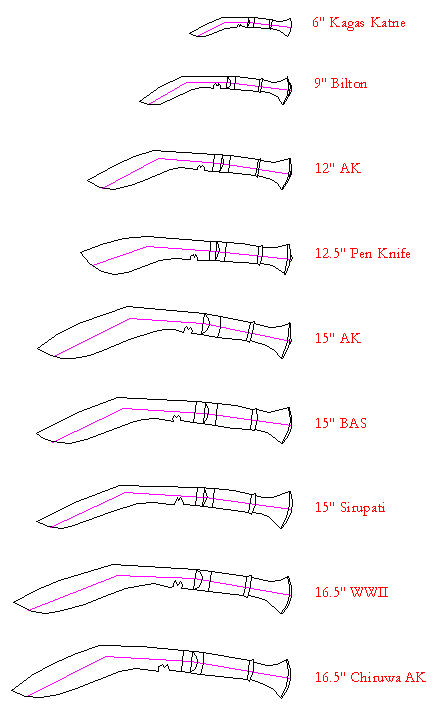
|
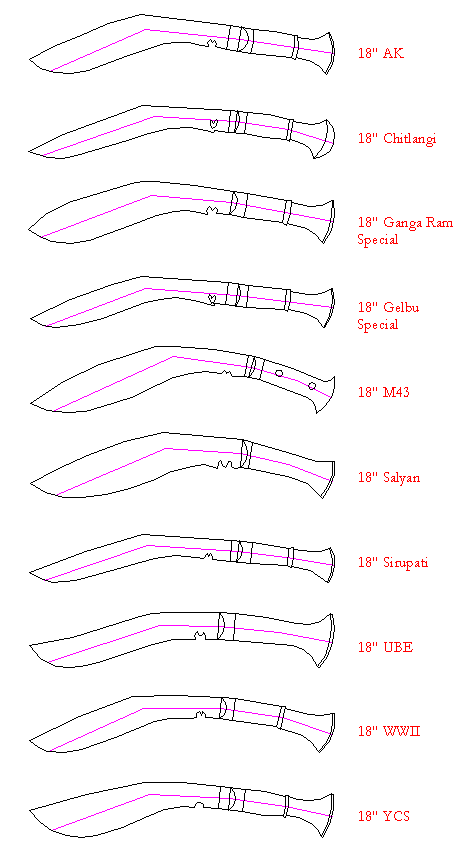
|
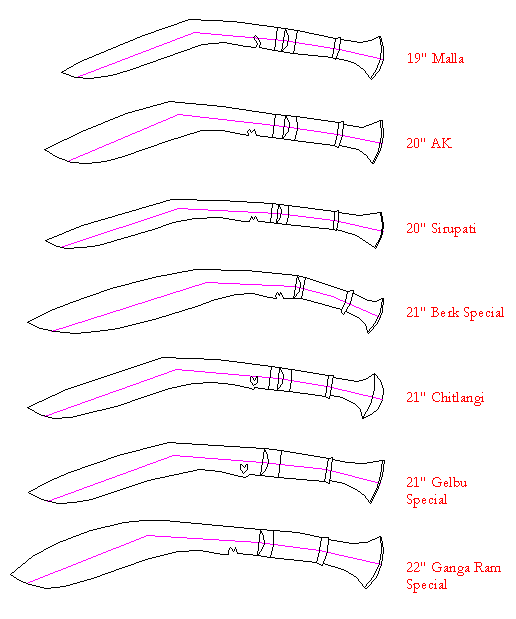
|

V. Here's the meat of the
analysis. A comparative look at final bend and effective striking angles.
Each Khukuri in the analysis is accompanied by 2 numbers: Name, Final Bend, Effective Striking Angle
* Final Bend = the last bend of the knife
* Effective striking angle = a line drawn from the end of the knife to the end of the handle.
**Note: the purple lines from the drawings in the section IV (above) were aligned together in this study so that the first line in the handle is perpendicular to a specific datum - in this case, the green line. The reason for this is so that a true bend angle can be compared (this makes a big difference when comparing the M43 which has a curved handle and an AK which has a straight handle) and in this way account for handle differences as well.
Imagine holding a khukuri with the handle exactly perpendicular to your body. Now imagine if you could hold 5 at the same time and judge each one to see how much they individually "bend". That's the intent of this analysis.
Let this be a guide for those who wonder what it would feel like to have an AK instead of a Sirupati, or a Gelbu Special instead of a Kobra.
While careful consideration was made for each khukuri individually, this analysis does not account completely for weight distribution along the blade, nor does it include variations by the individual kamis. Rather, it is a starting point for you to do your own analysis. For example: An 18" Sirupati and an 18" GRS share nearly the same angles. However, the blades are strikingly different in size and shape. One is a short sword, the other, a medium-duty chopper.
Also, consider the lines for the 18" UBE and 18" YCS. They are also nearly similar, and in fact have similar features. Go and check the diagrams above to see where the "purple line" was drawn against the profile of the knife. Comparing the 2 together, it's easy to distinguish the deep-belly YCS from the clip-point UBE. This becomes more apparent when you study the "Red-n-Blue" diagrams above.
Points of Interest:
1. Notice how many of the khukuris have the same Effective Strike Angle, despite having different Final Bend Angles - (in all but the 18" group).
2. A few that stand out as having extreme angles: 21" Berk Special (Dui Chirra), 18" Chitlangi, 18" WWII, 18" Salyan and 18" M43.
3. Note the shallow initial angle of the 20" AK and 22" GRS. Despite having aggressive Final Bend Angles, the khukuris is more "relaxed" overall - which may account for why both of these khukuris feel fairly comfortable, though heavy.
Each Khukuri in the analysis is accompanied by 2 numbers: Name, Final Bend, Effective Striking Angle
* Final Bend = the last bend of the knife
* Effective striking angle = a line drawn from the end of the knife to the end of the handle.
**Note: the purple lines from the drawings in the section IV (above) were aligned together in this study so that the first line in the handle is perpendicular to a specific datum - in this case, the green line. The reason for this is so that a true bend angle can be compared (this makes a big difference when comparing the M43 which has a curved handle and an AK which has a straight handle) and in this way account for handle differences as well.
Imagine holding a khukuri with the handle exactly perpendicular to your body. Now imagine if you could hold 5 at the same time and judge each one to see how much they individually "bend". That's the intent of this analysis.
Let this be a guide for those who wonder what it would feel like to have an AK instead of a Sirupati, or a Gelbu Special instead of a Kobra.
While careful consideration was made for each khukuri individually, this analysis does not account completely for weight distribution along the blade, nor does it include variations by the individual kamis. Rather, it is a starting point for you to do your own analysis. For example: An 18" Sirupati and an 18" GRS share nearly the same angles. However, the blades are strikingly different in size and shape. One is a short sword, the other, a medium-duty chopper.
Also, consider the lines for the 18" UBE and 18" YCS. They are also nearly similar, and in fact have similar features. Go and check the diagrams above to see where the "purple line" was drawn against the profile of the knife. Comparing the 2 together, it's easy to distinguish the deep-belly YCS from the clip-point UBE. This becomes more apparent when you study the "Red-n-Blue" diagrams above.
Points of Interest:
1. Notice how many of the khukuris have the same Effective Strike Angle, despite having different Final Bend Angles - (in all but the 18" group).
2. A few that stand out as having extreme angles: 21" Berk Special (Dui Chirra), 18" Chitlangi, 18" WWII, 18" Salyan and 18" M43.
3. Note the shallow initial angle of the 20" AK and 22" GRS. Despite having aggressive Final Bend Angles, the khukuris is more "relaxed" overall - which may account for why both of these khukuris feel fairly comfortable, though heavy.
a. small khukuris - 6-12.5 inches

b. 15-16.5 inch khukuris

c. 18 inch khukuris

d. 19-21 inch khukuris

e. 25-30 inch khukuris
